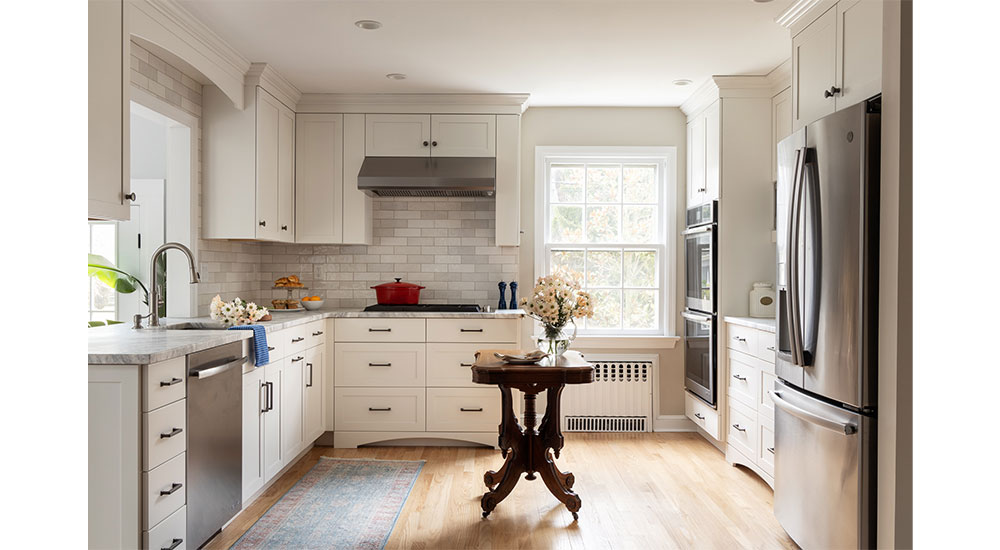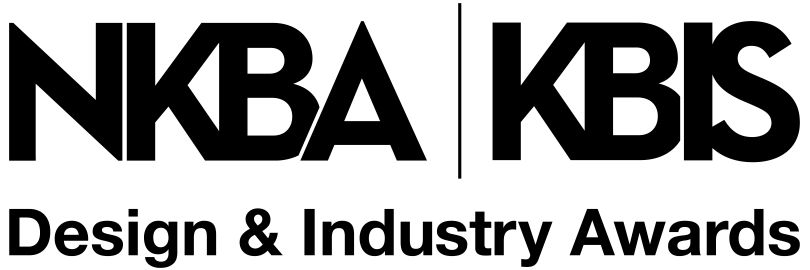One of the first questions I am asked during a discovery call is, “What kind of cabinets do you recommend?” And my answer is always that it depends. In my design practice, I work with custom, semi-bench-built and semi-custom cabinets. Each has its place, and selecting the right one comes down to what I call the big three: timeline, design requirements and budget.
Above photo: This lovely kitchen was designed by Sharon Sherman using semi-custom cabinets from Greenfield Cabinetry. Tailored details and accents were used to create a kitchen that reflects the clients’ love of traditional design. Photo credit: Mike Van Tassell
Semi-Custom Cabinets
Semi-custom cabinets offer a great balance of quality, flexibility and cost-effectiveness. They are factory-built after the order is placed and allow for limited customization. Most lines include a selection of woods, finishes, door styles and interior accessories from pullout pantries and spice racks to tray dividers and rollouts. They’re adjustable in width, height and depth, making them versatile in kitchens, baths, laundry rooms, mudrooms and home offices.
That said, semi-custom cabinetry comes with a defined catalog of components. You’re working within a system of options. The cabinet boxes are often standard, while the doors and drawer boxes are (typically dovetail maple, walnut or metal) sourced and assembled according to the design. The same goes for moldings, which may have limited design choices. Semi-custom manufacturers usually don’t make every piece in-house, but that doesn’t mean quality is compromised.
These cabinets are available in framed or frameless construction and offer both inset and overlay styles, accommodating most design aesthetics. When the design needs can be addressed using the catalog and the timeline is tight, semi-custom can be the perfect solution.
When to Go Custom
Like semi-custom, custom cabinets can be framed or frameless, inset or overlay, but what sets them apart is their range of customization. You’re not confined to catalog dimensions or materials. You can specify 1-inch-thick doors, custom paint and stain finishes and unique cabinet sizes. Many manufacturers even allow you to design your door style from scratch.
Need built-in lighting? Hidden outlets? Integrated appliance panels or cabinetry that wraps around an antique architectural beam? A custom line can deliver all that and more. Custom-fabricated metal and glass doors are easy to specify with the right custom cabinet maker.
These cabinets are engineered specifically for your project, built and finished together for consistency. And while that means longer lead times and a more involved design phase, the payoff is worth it when the space needs something special. Custom cabinets are ideal for projects with unique requirements, like a home study with architectural paneling, a highly specialized kitchen or a library where millwork plays a central role in the design story.
The Art of Bench-Built Cabinetry
This type of cabinetry is where craftsmanship meets artistry. Every component is handcrafted, hand-finished and hand-assembled. It’s the cabinetry equivalent of couture in fashion; each piece is designed to reflect the lifestyle, taste and individuality of the client.
You want quartersawn white oak veneer from a specific log? Done. A vanity finished in a custom-mixed glaze to match the exact undertone of your tile? Absolutely. Need a unique hardware style or an interior lined in leather or wallpaper? That’s possible, too. The only limit is your imagination and the availability of materials.
I’ve used bench-built cabinetry for heirloom vanities, one-of-a-kind libraries and other spaces where furniture-grade millwork is a must. These are investment pieces with design longevity that far outlive trends. And yes, they come with a longer lead time and a higher price tag, but in return you get a level of quality and uniqueness that simply can’t be replicated.
What’s the Right Choice?
The truth is, there’s no right answer. Choosing among semi-custom, custom or bench-built cabinetry comes down to your client’s timeline, your design vision and investment level. If your design fits within a manufacturer’s offerings and you’re on a tighter schedule, semi-custom can be a beautiful and practical choice. If you need more flexibility, want to specify materials or finishes outside the catalog or are working on a truly personalized space, custom is the way to go.
For those projects where the story of the home is told in every detail, bench-built is the ideal. It’s not just cabinetry. It’s an expression of craftsmanship and character. I don’t believe in one-size-fits-all. It’s about choosing the right solution for each client, each space and each story. And that starts with a thoughtful discovery conversation, where we begin with what matters most – how the home should function, what it should feel like and what’s needed to make it timeless.









